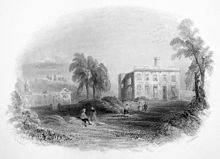John de Sotheron
Sir John de Sotheron (died after 1398) was an English landowner, lawyer and judge, who served briefly as Lord Chief Justice of Ireland.[1]

Background and early career
[edit]He was the son of Thomas de Sotheron or de Sotherne, Lord of the Manor of Great Mitton in Lancashire, and grandson of Sir Robert de Sotheron;[2] Mitton had passed by inheritance to the de Sotherons from the de Mitton family.[3] He inherited his father's lands in about 1369; at the time he was involved in a dispute with nearby Cockersand Abbey over the advowson (i.e. the right to select his own candidate as parish priest) of Mitton Church. In February 1368 he was the defendant in a claim for a debt of 40 shillings brought against him by William de Mirfeld.[4] He is known to have been acting as an attorney at this time.[5]
In 1377 he was pardoned for killing John de Holden. He lived in a violent age, where cases of manslaughter and even murder among the ruling class were not uncommon, and a royal pardon was easy enough to obtain; nor would a criminal record necessarily hinder one's career, as de Sotheron's own later life shows.[1]
Judge
[edit]In 1384 he was sent to Ireland as Chief Justice of the Irish Common Pleas, but instead took office as second justice of the Court of Common Pleas (Ireland),[6] and almost at once became Lord Chief Justice.[1] He served for one year, during which there is a record in the Patent Rolls of him as one of three senior judges who acted for the Lord Lieutenant of Ireland in his absence in hearing petitions.[7] He returned to England after a year, then came back to Ireland in the summer of 1386, as a legal adviser to Sir John Stanley, the Lord Lieutenant of Ireland, and was given letters of protection in June for the journey.[8] He remained in Ireland for several years; he lived then at Dangan, County Meath (his wife's family, the Cusacks, held substantial lands in Meath).[9] Ball states that his wife Joanna was kidnapped from Dangan Castle in 1392, but gives no further details of the episode.[1]

He returned to England sometime after 1392, was knighted, and retired to his estates in Lancashire.[1]
Family and later descendants
[edit]He married Joanna, daughter of Sir Simon Cusack,[2] who was summoned to the so-called Good Parliament of 1376 as Baron Culmullen, and had extensive lands in Ireland, including Culmullin and Dangan, County Meath.[9] Joanna and her sister Margaret presumably inherited a share of these lands, although their father had a son John by his second wife Nicola Bathe, who was apparently still a minor when his father died. His father had granted him the family estates at Dangan.[10] Nicola remarried another senior Irish judge, John de Shriggeley.[1] She and her second husband fought a long and bitter battle for possession of Culmullen against various Cusack relatives; the feud dragged on into the next generation, and caused a number of violent deaths.[11]
John and Joanna had two surviving children, Christopher and Isabella, who married Walter Hawksworth of Hawksworth, Yorkshire: her father gave her a dowry of 80 marks.[2] He was still living in 1397/8, when he and his son and heir Christopher were in dispute with Roger White and others as to the ownership of lands at Great Mitton.[3]
The Great Mitton estate passed to Christopher, who had two sons, John (living 1419), who was parish priest of Upton-cum-Chalvey, Buckinghamshire (now a suburb of Slough),[2] and Robert, who inherited the estates. His descendants remained at Great Mitton for several generations.[2] The family name was later spelt Sherburne.[3]
References
[edit]- ^ a b c d e f Ball, F. Elrington The Judges in Ireland 1221-1921 John Murray London 1926 Vol. 1 p.166
- ^ a b c d e The Reliquary and Illustrated Archaeologist- a Quarterly Review Vol. XV (1874-5)
- ^ a b c Whitaker, Thomas Dunham The History and Antiquities of the Deanery of Craven in the County of York 2nd edition J. Nichols and Son London 1812 p.21
- ^ Calendar of Close Rolls 14 February 1368
- ^ Calendar of Patent Rolls 2 January 1368
- ^ Patent Roll 8 Richard II
- ^ Patent Roll 9 Richard II
- ^ Patent Roll 9 Richard II
- ^ a b Patent Roll 21 Richard II
- ^ Calendar of Irish Chancery Letters c.1244-1509
- ^ Crooks, Peter Factionalism and Noble Power in English Ireland c.1361-1424 Published by Trinity College Dublin 2007


 French
French Deutsch
Deutsch